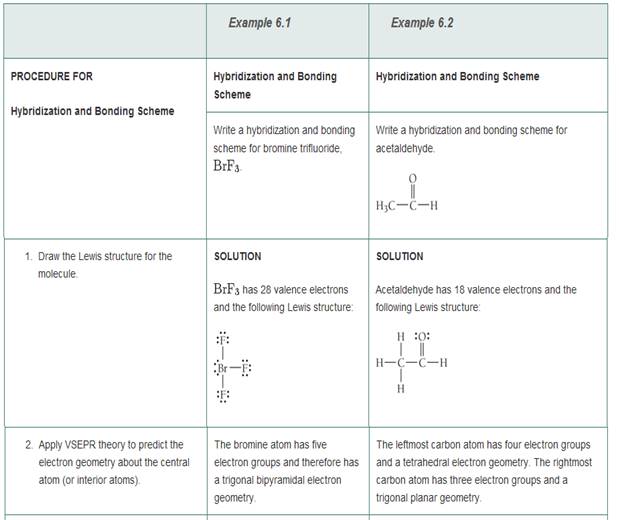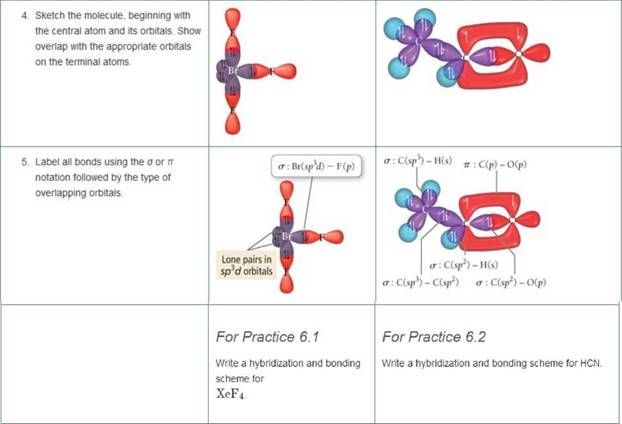
Modified Mastering Chemistry with Pearson eText -- Standalone Access Card -- for Chemistry: Structure and Properties (2nd Edition)
2nd Edition
ISBN: 9780134565613
Author: Nivaldo J. Tro
Publisher: PEARSON
expand_more
expand_more
format_list_bulleted
Textbook Question
Chapter 6, Problem 36E
Write a hybridization and bonding scheme for each molecule or ion. Sketch the structure, including overlapping orbitals, and label all bonds using the notation shown in Examples 6.1 and 6.2
- SO32-
- PF6-
- BrF3
- HCN



Expert Solution & Answer
Want to see the full answer?
Check out a sample textbook solution
Students have asked these similar questions
Write structural formulas for the major products by
doing addition reactions
1. You must add H2 as Pt is catalyst it does not take part in reactions
only speed up the process
H₂
CH2=CH-CH3
Pt
2. Add HCI break it into H and Cl
CH3
HCI
3. Add Br2 only CC14 is catalyst
CH3-CH=CH2
B12
CCl4
4. Add water to this and draw major product, H2SO4 is catalyst you have add
water H20 in both the reaction below
H₂SO4
CH3-CH=CH2
CH3
H2SO4/H₂O
CH3-C=CH2
reflux
?
Plan the synthesis of the following compound using the starting
material provided and any other reagents needed as long as
carbon based reagents have 3 carbons or less. Either the
retrosynthesis or the forward synthesis (mechanisms are not
required but will be graded if provided) will be accepted if all
necessary reagents and intermediates are shown (solvents and
temperature requirements are not needed unless specifically
involved in the reaction, i.e. DMSO in the Swern oxidation or
heat in the KMnO4 oxidation).
H
H
Hint These are benzene substitution reactions.
ALCI3 and UV light are catalyst no part in reactions and triangle A means
heating.
A. Add ethyl for Et in benzene ring alkylation reaction EtCl =
CH3CH2CL
1) EtC1 / AlCl3 / A
?
B: Add Br to benzene ring ( substitution)
2) Br₂ / uv light
?
C Add (CH3)2 CHCH2 in benzene ring ( substitution)
(CH3)2CHCH,C1 / AICI,
?
Chapter 6 Solutions
Modified Mastering Chemistry with Pearson eText -- Standalone Access Card -- for Chemistry: Structure and Properties (2nd Edition)
Ch. 6 - Prob. 1ECh. 6 - What is a chemical bond according to valence bond...Ch. 6 - In valence bond theory, what determines the...Ch. 6 - In valence bond theory, the interaction energy...Ch. 6 - What is hybridization? Why is hybridization...Ch. 6 - How does hybridization of the atomic orbitals in...Ch. 6 - How is the number of hybrid orbitals related to...Ch. 6 - Sketch each hybrid orbital sp sp2 sp3 sp3d sp3d2Ch. 6 - Prob. 9ECh. 6 - Name the hybridization scheme that corresponds to...
Ch. 6 - What is a chemical bond according to molecular...Ch. 6 - Explain the difference between hybrid atomic...Ch. 6 - What is a bonding molecular orbital?Ch. 6 - Prob. 14ECh. 6 - What is the role of wave interference in...Ch. 6 - Prob. 16ECh. 6 - Prob. 17ECh. 6 - Prob. 18ECh. 6 - Prob. 19ECh. 6 - Prob. 20ECh. 6 - Prob. 21ECh. 6 - When applying molecular orbital theory to...Ch. 6 - In molecular orbital theory, what is a nonbonding...Ch. 6 - Write a short paragraph describing chemical...Ch. 6 - The valence electron configurations of several...Ch. 6 - The valence electron configurations of several...Ch. 6 - Draw orbital diagrams (boxes with arrows in them)...Ch. 6 - Draw orbital diagrams (boxes with arrows in them)...Ch. 6 - Prob. 29ECh. 6 - Draw orbital diagrams (boxes with arrows in them)...Ch. 6 - Which hybridization scheme allows the formation of...Ch. 6 - Which hybridization scheme allows the central atom...Ch. 6 - Write a hybridization and bonding scheme for each...Ch. 6 - Write a hybridization and bonding scheme for each...Ch. 6 - Write a hybridization and bonding scheme for each...Ch. 6 - Write a hybridization and bonding scheme for each...Ch. 6 - Write a hybridization and bonding scheme for each...Ch. 6 - Write a hybridization and bonding scheme for each...Ch. 6 - Consider the structure of the amino acid alanine...Ch. 6 - Consider the structure of the amino acid aspartic...Ch. 6 - Sketch the bonding molecular orbital that results...Ch. 6 - Sketch the antibonding molecular orbital that...Ch. 6 - Draw an MO energy diagram and predict the bond...Ch. 6 - Draw an MO energy diagram and predict the bond...Ch. 6 - Sketch the bonding and antibonding molecular...Ch. 6 - Sketch the bonding and antibonding molecular...Ch. 6 - Using the molecular orbital energy ordenng for...Ch. 6 - Using the molecular orbital energy ordering for...Ch. 6 - Apply molecular orbital theory to predict if each...Ch. 6 - Apply molecular orbital theory to predict if each...Ch. 6 - According to MO theory, which molecule or ion has...Ch. 6 - According to MO theory, which molecule or ion has...Ch. 6 - Draw an MO energy diagram for CO. (Use the energy...Ch. 6 - Draw an MO energy diagram for HCI. Predict the...Ch. 6 - For each compound, draw the Lewis structure,...Ch. 6 - For each compound, draw the Lewis structure,...Ch. 6 - Amino acids are biological compounds that link...Ch. 6 - The genetic code is based on four different bases...Ch. 6 - The structure of caffeine, present in coffee and...Ch. 6 - The structure of acetylsalicylic acid (aspirin) is...Ch. 6 - Draw a molecular orbital energy diagram for CIF....Ch. 6 - Draw Lewis structures and MO diagrams for CN+, CN,...Ch. 6 - Bromine can form compounds or ions with any number...Ch. 6 - The compound C3H4 has two double bonds. Describe...Ch. 6 - How many hybrid orbitals do we use to describe...Ch. 6 - Prob. 66ECh. 6 - In VSEPR theory, which uses the Lewis model to...Ch. 6 - The resuts of a molecular orbital calculation for...Ch. 6 - Prob. 69ECh. 6 - cis-2-Butene isomerizes (changes its structure) to...Ch. 6 - The ion CH5 + can form under very special...Ch. 6 - Neither the VSEPR model nor the hybridization...Ch. 6 - Prob. 73ECh. 6 - The most stable forms of the nonmetals in groups...Ch. 6 - Consider the bond energies of three iodine...Ch. 6 - How many atomic orbitals form a set of sp3hybrid...Ch. 6 - Have each group member pick one of these...Ch. 6 - Divide your group into two subgroups. Have one...Ch. 6 - A molecular orbital calculation for Hi results in...Ch. 6 - Determine the hybridization about 0 in CH3OH.Ch. 6 - Determine the hybridization about C in H2CO.Ch. 6 - According to the valance bond theory, which kind...Ch. 6 - Use molecular orbital theory to determine the bond...Ch. 6 - Use molecular orbital theory to predict which...Ch. 6 - Use molecular orbital theory to determine which...Ch. 6 - Which hybridization scheme occurs about nitrogen...Ch. 6 - Prob. 8SAQCh. 6 - Prob. 9SAQCh. 6 - Prob. 10SAQCh. 6 - Which type of orbitals overlap to form the sigma...
Knowledge Booster
Learn more about
Need a deep-dive on the concept behind this application? Look no further. Learn more about this topic, chemistry and related others by exploring similar questions and additional content below.Similar questions
- Draw the mechanism to make the alcohol 2-hexanol. Draw the Mechanism to make the alcohol 1-hexanol.arrow_forwardDraw the mechanism for the formation of diol by starting with 1-pentanal in... basic conditions then acidic conditions then draw the mechanism for the formation of a carboxylic acid from your product.arrow_forwardIdentify each chiral carbon as either R or S. Identify the overall carbohydrates as L or Darrow_forward
- Ethers can be formed via acid-catalyzed acetal formation. Draw the mechanism for the molecule below and ethanol.arrow_forwardHOCH, H HO CH-OH OH H OH 11 CH₂OH F II OH H H 0 + H OHarrow_forwardDraw the mechanism for the formation of diol by starting with one pen and all in... basic conditions then acidic conditions then draw the mechanism for the formation of a carboxylic acid from your product.arrow_forward
arrow_back_ios
SEE MORE QUESTIONS
arrow_forward_ios
Recommended textbooks for you
 Chemistry: Principles and ReactionsChemistryISBN:9781305079373Author:William L. Masterton, Cecile N. HurleyPublisher:Cengage Learning
Chemistry: Principles and ReactionsChemistryISBN:9781305079373Author:William L. Masterton, Cecile N. HurleyPublisher:Cengage Learning Chemistry: Principles and PracticeChemistryISBN:9780534420123Author:Daniel L. Reger, Scott R. Goode, David W. Ball, Edward MercerPublisher:Cengage Learning
Chemistry: Principles and PracticeChemistryISBN:9780534420123Author:Daniel L. Reger, Scott R. Goode, David W. Ball, Edward MercerPublisher:Cengage Learning
 ChemistryChemistryISBN:9781305957404Author:Steven S. Zumdahl, Susan A. Zumdahl, Donald J. DeCostePublisher:Cengage Learning
ChemistryChemistryISBN:9781305957404Author:Steven S. Zumdahl, Susan A. Zumdahl, Donald J. DeCostePublisher:Cengage Learning Chemistry: An Atoms First ApproachChemistryISBN:9781305079243Author:Steven S. Zumdahl, Susan A. ZumdahlPublisher:Cengage Learning
Chemistry: An Atoms First ApproachChemistryISBN:9781305079243Author:Steven S. Zumdahl, Susan A. ZumdahlPublisher:Cengage Learning Chemistry for Engineering StudentsChemistryISBN:9781337398909Author:Lawrence S. Brown, Tom HolmePublisher:Cengage Learning
Chemistry for Engineering StudentsChemistryISBN:9781337398909Author:Lawrence S. Brown, Tom HolmePublisher:Cengage Learning

Chemistry: Principles and Reactions
Chemistry
ISBN:9781305079373
Author:William L. Masterton, Cecile N. Hurley
Publisher:Cengage Learning

Chemistry: Principles and Practice
Chemistry
ISBN:9780534420123
Author:Daniel L. Reger, Scott R. Goode, David W. Ball, Edward Mercer
Publisher:Cengage Learning


Chemistry
Chemistry
ISBN:9781305957404
Author:Steven S. Zumdahl, Susan A. Zumdahl, Donald J. DeCoste
Publisher:Cengage Learning

Chemistry: An Atoms First Approach
Chemistry
ISBN:9781305079243
Author:Steven S. Zumdahl, Susan A. Zumdahl
Publisher:Cengage Learning

Chemistry for Engineering Students
Chemistry
ISBN:9781337398909
Author:Lawrence S. Brown, Tom Holme
Publisher:Cengage Learning
Linear Combination of Atomic Orbitals LCAO; Author: Edmerls;https://www.youtube.com/watch?v=nq1zwrAIr4c;License: Standard YouTube License, CC-BY
Quantum Molecular Orbital Theory (PChem Lecture: LCAO and gerade ungerade orbitals); Author: Prof Melko;https://www.youtube.com/watch?v=l59CGEstSGU;License: Standard YouTube License, CC-BY